Home » Other Articles » Tuesday Treasures Index » Tuesday Treasures - February 2024 - Tuesday Treasures - February 2024
Tuesday Treasures - February 2024
TUESDAY 27 FEBRUARY
Barmouth
We travel to the Cambrian Mountains this week and the town of Barmouth. Situated on the shore of Cardigan Bay, it has long been a popular holiday destination ever since the opening of the railway in 1867. Its beautiful location on the mouth of the Afon Mawddach, Merionethshire (now part of Gwynedd) has made it a magnet for holidaymakers and before the advent of mass car ownership, the station saw regular through trains from London, the Midlands and the North West. Between Dovey Junction and Pwllheli passengers were and still are treated to some spectacular views of the Cambrian coast, crossing the Mawddach on the most significant civil engineering structure on the line, Barmouth Bridge.
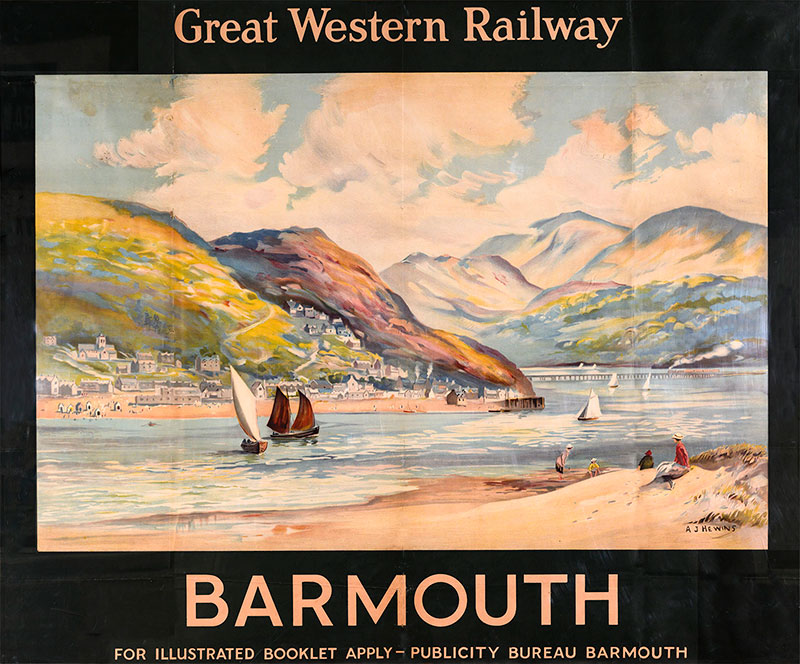
The first poster dates from 1924 and is a stunning view with the artist, A J Hewins, using some licence in looking across to the town with the brooding mountains above and a down train crossing the bridge. Although published in the mid 1920s, the liberated society of the time had obviously not reached North Wales as bathing machines are still in evidence on the beach, there to protect the local citizens from the low morals of the big city visitors.
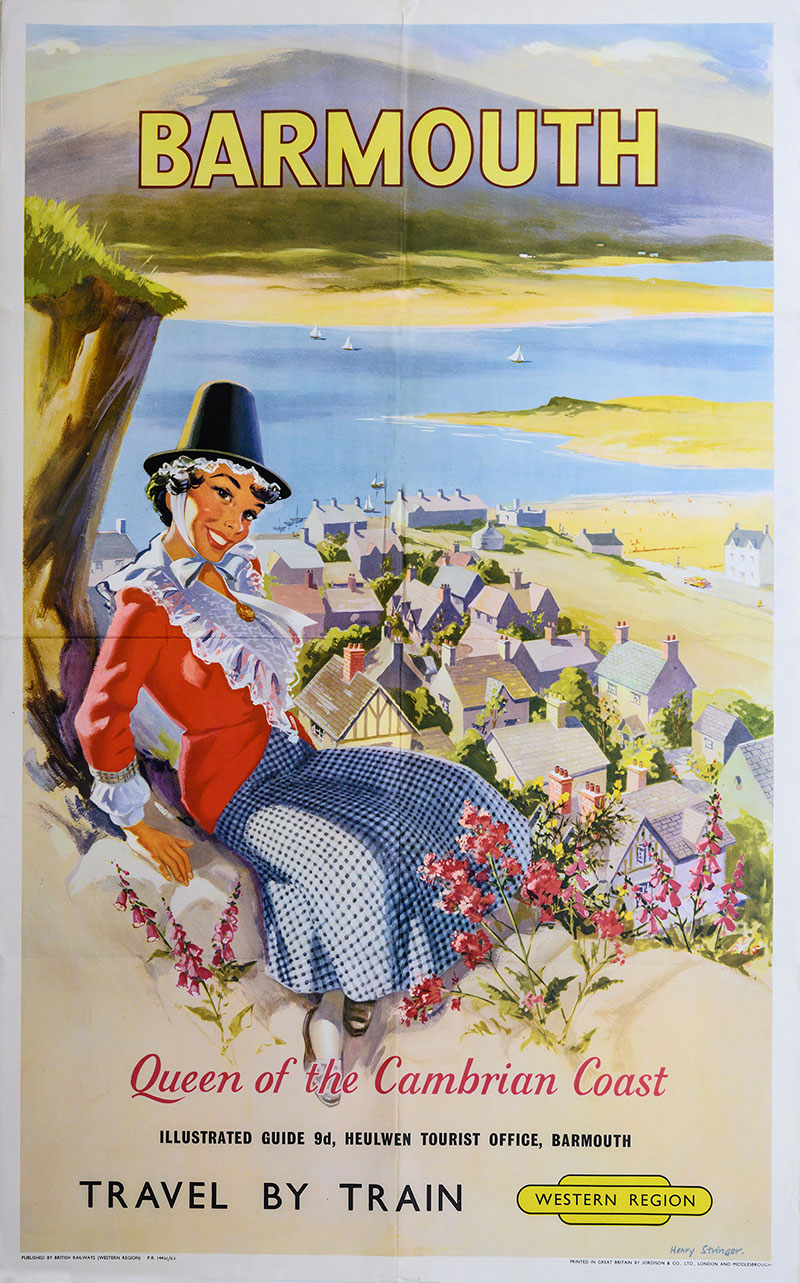
Our second poster was issued in 1962 and is in a very different style. Gone are the big skies and distant figures. Instead, the main attraction is a very shapely lady in traditional Welsh costume whose presence draws the viewer into to the town beyond. Exactly what the artist, Henry Stringer (1903-1993), would have wanted, although one cannot help wondering if he was also a fan of Sophia Loren and other Hollywood stars of the time.
Both of these posters form part of the Great Western Trust collection and others are on display in the Trust Museum at Didcot Railway Centre, home of the Great Western Society.
TUESDAY 20 FEBRUARY
A Special Consideration
Those familiar with the name Cecil J Allen will know of his very extensive locomotive running logs and observations on all the Big Four railway lines that were published over many years in The Railway Magazine. He could only obtain direct, footplate access on many trains, through a generous provision or rather special consideration, by the senior managers on those lines including the GWR. From our Great Western Trust collection we illustrate a modest commercial postcard image that most helpfully had a detailed longhand annotation on its reverse that proves this point.
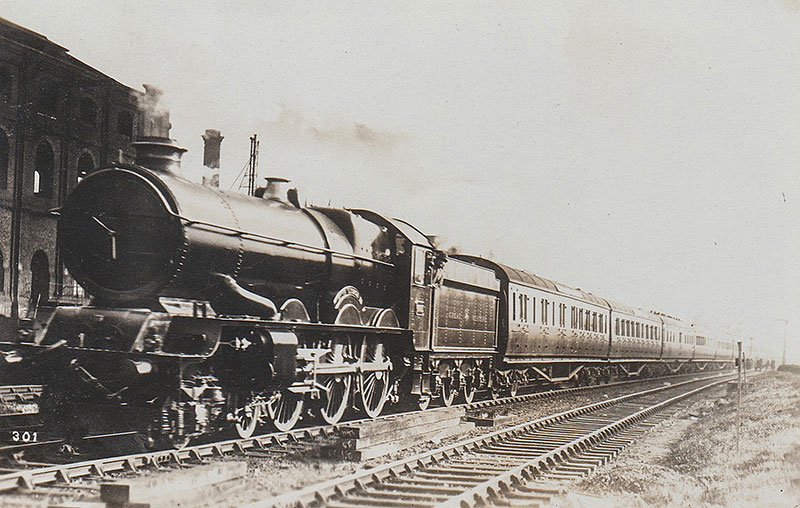
The Cornish Riviera Limited on 17 October 1927 with Cecil J Allen on the footplate. Photograph by F E Mackay
It may often be said that there is no such thing as bad publicity, but of course in the case of a working railway, a contemporary and much published observer of footplate and locomotive performance under daily operations like C J Allen, brought the risk of him experiencing a bad day at the workplace! Hence, to keep an eye upon C J Allen, his interaction with the footplate crew, and represent the GWR Company officially, a senior loco inspector always accompanied him on such journeys.
The train in question is the down Cornish Riviera Limited express on 17 October 1927, just passing Kensal Green. Loco No 6005 King George II, is being driven by Driver W Rowse and Fireman J Osborne, with Chief Inspector Robinson overseeing activities. Cecil J Allen is leaning out from the cab, with distinctive hat, having pre-arranged with the photographer F E Mackay the location for this photo opportunity! With the introduction of the King class locomotives, the non-stop schedule from Paddington to Plymouth was reduced from 248 minutes to an even four hours.
Cecil J Allen was born in 1886 and died on 5 February 1973. He joined the Great Eastern Railway in 1903 and went on to become an inspector of materials for the LNER. He also had a prolific career as a writer, publishing many books on railway subjects. He authored the long-running monthly series British Locomotive Practice and Performance from 1909 to 1958 in The Railway Magazine.
He was a supporter of the Crusaders’ Union and organised three special trains in January 1929 to take members of the Union from Paddington to Swindon Works, as well as tours in subsequent years.
Cecil J Allen described his journey on the Cornish Riviera Limited Express in October 1927 in British Locomotive Practice and Performance published in The Railway Magazine’s December 1927 edition. A set of bound volumes of The Railway Magazine is also in the Great Western Trust collection. We reproduce the article below as it captures the atmosphere of a long non-stop journey on a powerful steam locomotive with a heavy train.
For those unfamiliar with steam engine terminology, the regulator is the valve which lets steam from the boiler to the cylinders, and the cut-off controls the valves which admit steam to the cylinders, and remove it afterwards to be exhausted out of the chimney. The lower the number, the more efficiently the engine is working, so a 15 per cent cut-off means steam is admitted to the cylinders for 15 per cent of the piston stroke and the steam expands to drive the piston for the remainder of the stroke. When the engine is slogging up a gradient more power is required from the cylinders, so a 35 per cent cut-off admits steam for more than a third of the piston stroke.
Slip coaches might also be a mystery to some. This is a practice of detaching a coach or coaches from the rear of a train while it is on the move. The main train carries on without stopping, while the detached vehicles coast to a halt in the station under control of a slip guard. The advantage for the Cornish Riviera Limited on its non-stop journey from Paddington to Plymouth was that the original 14 coaches at the start of the journey had reduced to seven after slips at Westbury, Taunton and Exeter, giving the engine an easier task in tackling the steep gradients between Newton Abbot and Plymouth.
Now let us sit back and enjoy Cecil J Allen’s description of the journey:
British Locomotive Practice and Performance, December 1927
It is not unnatural that the most urgent desire of many readers who make a close study of locomotive performance should be – judging by their letters – to know something of the achievements of the latest locomotive masterpiece from Swindon. On paper there has been little question as to the new King George V class being the most powerful express passenger locomotive in the country. The tractive force formula gives the engine an advantage even over the 4-6-2 Pacific Enterprise of the LNER with its enhanced working pressure of 220 lb sq in.
But the question of real interest was to see whether the King George V boiler could supply steam with sufficient rapidity to make the tractive force calculation effective, and in particular to ascertain if it would be possible to maintain the high working pressure of 250 lb continuously in maximum conditions of working.
By the courtesy of Mr C B Collett CBE, Chief Mechanical Engineer of the Great Western Railway, to whom this wonderful design owes its inception and its execution, I have been able to obtain, as an eye-witness, the answer to both questions. And let me say here, without delay, that it is a triumphant affirmative.
Six years ago I made my first down journey on the Cornish Riviera Limited express. Stars were the 4-6-0 engines then in the ascendant on the GWR, and it was with Lode Star that Driver Springthorpe gave me that remarkable journey described in the December issue of 1921, whereon we gained no less than 16 minutes on schedule between Westbury and Lipson Junction. Loads were much lighter in those days. Our 430 tons from Paddington dropped to 360 at Westbury, 295 at Taunton and 260 at Exeter.

No 4079 Pendennis Castle departing from Paddington station with the Cornish Riviera Limited, photograph by H W Peckham. Cecil J Allen rode from Paddington to Plymouth on the same train with this locomotive in October 1924 and compares performance of the Castle class with the new King class throughout this article
Then, in 1924 – exactly three years later – it was my privilege to ride down with Driver Young on Pendennis Castle, in a second trip specially memorable in that we succeeded with a train 100 tons heavier than that hauled by Lode Star, in passing Westbury 95 min 35 sec after leaving Paddington. This was detailed in December 1924.
And now, in December 1927, I have to describe my first journey on one of the new Kings, of the more comparative value in that the load behind King George II was almost identical with that carried behind Pendennis Castle three years before. But the King has the harder task, partly on account of that particular handicap which is impossible to reduce to figures – a strong head wind, which at times became a side wind – and partly because of the fuel, to which I will have occasion to refer later.
The three journeys were all made at about the middle of October, when the Limited is generally at its heaviest, after the post-summer restoration of the Taunton and Exeter slip portions. The last two journeys were made on Mondays, also, when extra load is usually carried, particularly on the Exeter slip.
It was encouraging, as I crossed the bridge from Bishop’s Road, to notice that the Falmouth coach was underneath it, which meant that both the St Ives and Penzance portions must be further still up No 1 platform; but a final examination of the train showed that my previous maximum of 14 vehicles had not been exceeded. However, this aggregate tare of 491 tons, with the train well filled in every part, gave promise of a gross load of fully 525 tons behind the engine tender.
From the rear end the formation of the train consisted of two 70 ft coaches for Weymouth, to be slipped at Westbury; a 70 ft for Minehead and a 60 ft for Ilfracombe, to be slipped at Taunton; a 70 ft and a 60 ft for Exeter and a 70 ft for Kingsbridge, to be slipped at Exeter; and then, in the main part of the train, 70 ft coaches for Newquay, Falmouth and St Ives, and a four-coach set, including restaurant car, for Penzance. I know of no other express in the country carrying in its formation as many as nine independent portions.
On reaching the engine, I found that I was travelling with Driver Rowse, Fireman Osborne and Chief Locomotive Inspector Robinson. In the commodious cabs with which these engines are fitted there was comfortable room for all of us. As regards weather, the day which had opened dull and cloudy, was beginning to improve, with the sun just breaking through, but rather a nasty wind getting up from the west.
The fuel – the other important point bearing on the journey – looked satisfactory to outward appearances; but it was to be discovered later that under the large lumps of coal which had been brought forward to the tender was a considerable quantity of slack that was little better than dust.
It was a shade after time when the signal was given to start, and at about 10.30½ Rowse opened the regulator, moderately at first, in order to avoid the possibility of slipping. Full forward gear was employed until we were well under way, but the cut-off was brought back until, no further from the start than West London Junction, King George II was cutting-off at 23 per cent of the stroke. By Hanwell this was down to 20 per cent, and by West Drayton we had actually got down to 17 per cent. Meanwhile, the regulator had been opened to nearly its full opening, which was the general position for all of the harder running, except for the fact that it showed a slight tendency to work backwards of itself from time to time, to a position which appeared, from the angle of the regulator handle on the quadrant plate, to be about three-quarters open.
From Hanwell to West Drayton we accelerated on the level from 55 to 60½ mph, on 20 per cent cut-off, and from there to Slough, with but 17 per cent cut-off, the engine worked this vast train up to a speed of 62½ mph. It was astonishing, on my previous trip with Pendennis Castle, to record a maximum of 69 miles an hour at the same point, with the engine cutting-off at 26 per cent of the stroke, but a speed of 62½ an hour with the same load of 525 tons, at no more than 17 per cent cut-off, seemed a perfectly amazing experience. I doubt, indeed, if it could be paralleled with a simple locomotive in any part of the world, apart from the use of valve motions of the Caprotti, Lentz or other special types. Of all the achievements of our engine throughout this four hours’ journey, no feat was to me more striking than this.
Immediately after Slough there came a permanent way check, which brought us down to 40 miles an hour, but for recovery from this it was not necessary to open out the engine to more than 22 per cent cut-off, and by Maidenhead we were down again to 20 per cent. But the acceleration here, once we had got above 50 miles an hour, was somewhat slow, although we had just contrived to attain the mile-a-minute rate at Sonning when steam was shut off for the Reading slack.
The silent working of the great engine, no less than the steadiness of her running, was most impressive; it seemed impossible on the footplate to realise the colossal output of energy, sufficient to move this gross weight of over 650 tons at an average rate of 60 miles an hour. Indeed the exhaust of the engine was completely inaudible, even on the footplate, at any cut-off below 20 per cent – that is to say for the major part of the journey – and not until 30 per cent, which was only reached at three different points, did it become really vigorous. But a backward view of the one-fifth-of-a-mile length of our train, winding round the curves from Reading to Southcote Junction, was enough to dispel any illusions as to the problem of haulage which lay both behind and before us.
To Reading we had dropped 3¼ min on schedule, of which the permanent way slack accounted for slightly over 1½ min, the remainder of the loss going against the engine. But we were to see later that there was method behind this apparently easy working.
After the Reading slack, Driver Rowse still left his cut-off at 20 per cent, and this all but brought us to the mile-a-minute rate before Aldermaston, where for the second time we were badly slacked for permanent way repairs. For recovery from the second check a cut-off of 21 per cent was employed for a short time, but this was brought back at Thatcham to 19 per cent, which sufficed to raise the speed to 57½ mph on the slight descent beyond Enborne Junction. It should be emphasised, however, that in general grading up the Kennet Valley is against the engine, with an average of 1 in 400 from Theale to Kintbury; and yet a cut-off position below 20 per cent was found enough for maintained speeds of over 55 mph. At Kintbury the grades steepen slightly, but it was not till Hungerford that the cut-off was advanced to 20 per cent, and then by 1 per cent at a time – on what other line than the Great Western could such artistic precision of driving method as this be seen? – we moved steadily up to a maximum of 24 per cent, just before topping Savernake Summit. Nothing more than 24 per cent to take a 525 ton express up 3 miles steepening from 1 in 175 to 1 in 106 – the culmination of a 30 mile rise – at a minimum rate of 49 miles an hour! It was a miracle. We had dropped 5 minutes to Bedwyn, but the majority of this loss could be debited to the two slacks; steady recovery of time was now the order of the day.
Once over Savernake Summit, Driver Rowse reduced the cut-off to 15 per cent, and substituted the small auxiliary port of the regulator for the main opening, and in this way we drifted smoothly down the Westbury, only missing the attainment of 80 miles an hour, below Lavington, by the narrow margin of a single mile. Relieved of the Westbury slip portion, and thus with a gross load of 450 tons, King George II now performed some remarkable work up the Brewham Summit, better known, perhaps, by its familiar title of “mile post 122¾”.
In recovering from both Westbury and Frome slacks, the 25 per cent cut-off position was employed, with the regulator a little short of fully open, but whereas Young (who was before time on my Pendennis Castle trip), had been content with between 22 and 23 per cent from beyond Frome up to Brewham, Rowse maintained his 25 per cent cut-off to the top. The difference in the two speeds was amazing; up the last mile at 1 in 107-112, Pendennis Castle fell to 39½ mph, whereas King George II with a cut-off but 2 per cent longer, carried the same load over the top at no less than 51 miles an hour!
We then travelled with the utmost gaiety over the easy length from Brewham to Cogload, cutting-off at 15 per cent, and with the auxiliary regulator port, as nearly as I could judge, fully open; speed slightly exceeded 80 mph below Bruton, was eased slightly past Castle Cary, and then reached 74 at three different points to Cogload. In this way we regained 3½ minutes between Westbury and Cogload Junction, and were now only 1½ minutes “down” in our total time from Paddington.
It was at this point that the fire began to give some concern to the crew. Pressure had been consistently maintained at round about 240 lb per square inch for most of the journey until now, but as we approached Taunton the needle was inclined to droop, so that we had not here more than 220 lb of steam. Throughout the journey it had been necessary for Fireman Osborne to make frequent recourse to the pricker, and his labours in firing had gradually assumed a more arduous form owing to the poor quality of the coal.
The ”attack” on Wellington bank had, therefore, to be made rather less strenuously than is normally the case, and on the new schedule of the train we lost 1½ minutes between Cogload and Exeter. Owing to the lower steam pressure, which fell to exactly 200 lb at the top of the bank, the cut-off positions had to be almost exactly the same as those of Pendennis Castle on my previous trip – 20 per cent at mile post 167¾, where the incline proper begins, gradually increased to 30 per cent past Wellington and 35 up the final mile. But the speed on the upper part of the bank was considerably higher, being 40½ mph at mile post 173 (at the mouth of Whiteball Tunnel; the summit of 2½ miles rising at 1 in 80-90) as against Pendennis Castle’s 31 mph. Even in adverse conditions, therefore, the superior power of King George II was abundantly apparent.
From Whiteball down to Exeter, we reverted to 15 per cent cut-off and the auxiliary regulator port, and the latter was not fully opened, in order that the steam supply might be husbanded to the greatest degree possible while the favourable grades permitted. The crew were thus rewarded by seeing the pressure gauge needle creep up to the “240” mark as we breasted Exeter.
We were thus 3 min down on the schedule allowance of 174½ min for the 173.7 miles from Paddington to this point, but by the release of the three vehicles forming the Exeter slip, our load had now shrunk to exactly one-half the fourteen coaches pulled out of Paddington, and such was the relief that Driver Rowse proceeded to regain the whole of the arrears on the next 20 miles to Newton Abbot.
Although in no more that 15 per cent cut-off, and with the regulator not more than one-half open, the engine regained speed with extraordinary rapidity along the level shores of the Exe, so that we dashed across Exminster troughs at fully 73 mph; after this followed the necessary easing round the curves past Starcross, Dawlish and Teignmouth, and a severe slack though the new station at Newton Abbot.
Now the formidable ascent of Dainton lay ahead, and directly we were past Newton the regulator handle was pushed hard over, and the cut-off advanced to 20 per cent. Up the final two miles, steepening from 1 in 57 to 1 in 41, and including a short strip at 1 in 36, cut-off changes were rapid, until finally we threaded the short tunnel, and passed Dainton Box – an operation which, from the footplate, looks like running over the gable end of a house – in 35 per cent cut-off. Pendennis Castle had gone over at 24½ mph in 42 per cent cut-off; we went over at 27½ mph in 35 per cent cut-off. Loads were identical, and in both cases the regulators were full open; such comparisons speak for themselves.
Down the incessantly winding descent to Totnes we went with great caution, and passed that station ½ min inside time. There now lay ahead Rattery bank; the first 2½ miles to Tigley Box steepening from just under 1 in 70 to 1½ miles continuously at 1 in 46-57; then 1¾ miles, mostly at 1 in 90 to Rattery Box; and a rather easier mile to the 228½ mile post, whence there are moderately rising grades to Wrangaton.
With regulator full open, Rowse advanced his cut-off gradually to 35 per cent, on the steepest part of the bank, and maintained it there up the 1 in 90 from Tigley to Rattery, whereby we accelerated from 28½ to 43½ mph up 1¾ miles of this grade. Pendennis Castle, at 33 per cent, merely gained the difference between 27 and 33 mph. Then our cut-off was dropped to 25 per cent at Rattery, further to 20 just beyond Rattery Tunnel – although this did not prevent us from attaining 60 mph up the rising grades past Brent – and 15 per cent at Wrangaton, where the auxiliary port once again replaced the main regulator opening.
All our troubles were now over. We had lost a minute between Totnes and Brent – the working times optimistically require an average rate of 45 mph up this ascent! – but we were on the right side of time at Hemerdon. Down the famous descent of Hemerdon with closed regulator and frequent brake applications; cautiously round the curves from Tavistock Junction to Lipson Junction; 23 per cent and an open regulator up the last stretch to Mutley; and we rolled proudly under the roof at North Road and came to a dead stand at 2.28·20 pm, 237 min 50 sec after leaving Paddington, and nearly 1¾ min early.
Little remains to be said about the run. When we got down to Laira Shed, the engine proved to be perfectly cool in every bearing, and apparently quite fit for an immediate return to London. Not so the crew and “passengers”, however. I should not like to say how long I spent in scraping off my superabundant coating of grime; the four of us certainly bore no uncertain evidences of the character of the coal which had been burned. But for all that, I would not have missed the experience; it was an education.
Had I been a passenger in the train, I should have wondered at the comparative moderation of the descent from Whiteball to Exeter, when the train was behind time; on the footplate the reason, of course, was obvious. But the coal, the wind, the slacks and the accelerated schedule combined, between them, further to enhance the merit of a wonderful journey; and it is on occasion such as these, when difficulties have to be surmounted, that one realises the wealth of experience and scientific skill that is bound up with successful driving and firing. My warmest appreciation, ere we parted, was expressed to Driver Rowse and Fireman Osborne; I hope that I may have some more
TUESDAY 13 FEBRUARY
British Industries Fair 1934
The Great Exhibition of 1851 began a trend for such nationally focused events that lasted at least until the Festival of Britain in 1951. Perhaps less well known are the more specialised exhibitions that had one subject at their focus. One such that we illustrate today from the Great Western Trust collection was the British Industries Fair of 19 February to 2 March 1934, held 90 years ago in London and Birmingham.

The two locations reflected their then established role as major centres of commerce and railway communication. London for its industries, now largely office or “Technology Park” focused but once having quite heavy industry in the suburbs, and Birmingham, well established as the manufacturing centre for countless industries.
The items illustrated are unused and complete, special vouchers for reduced fares to this exhibition, printed and issued jointly by the Great Western Railway Co and the London Midland & Scottish Railway Co, as a shared venture, acknowledging that both companies had direct train routes from London to Birmingham. So we have the cover of the enclosing folder for the multiple parts, its inclusive timetables of trains on both systems and the Voucher No 1 images.
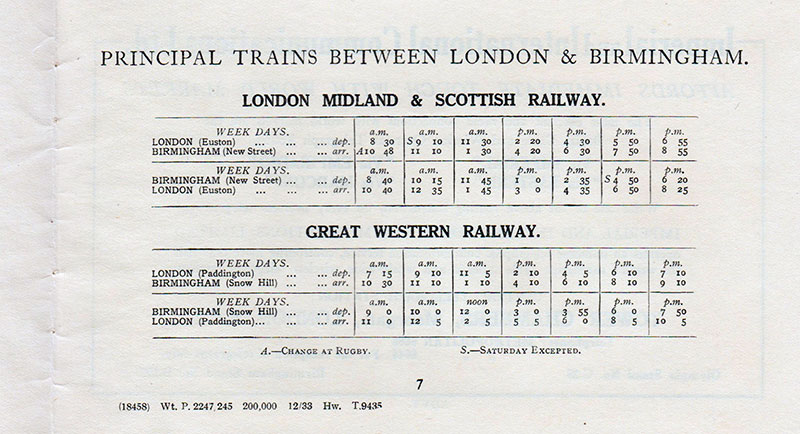
From the very small print on the timetable illustration, it shows a remarkable run of 200,000 in preparation dated December 1933! Yes, these events drew massive attendance, but quite how many vouchers such as these were actually used on either railway route, is sadly unknown.
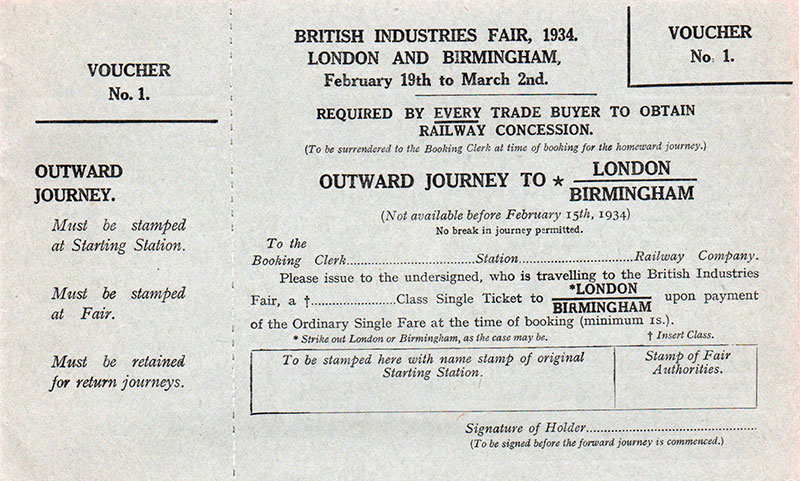
The photographs of station decorations at Paddington in 1950 and Birmingham Snow Hill in 1951 show the efforts made by the railways to add a sense of occasion for travellers to the Fair.
A short history of the Fair
This history of the Fair is published on the National Archives website:
“The first British Industries Fair (BIF) was held in 1915 at the Royal Agricultural Hall, London, in an attempt to encourage British firms to produce goods which had traditionally been imported from Germany and other countries. Only the exhibition of British goods was permitted and a total of nearly 34,000 attended. The success of the first Fair led to further Fairs being held in 1916 and 1917 at the Victoria & Albert Museum, and in 1918 and 1919 at the London Docks.
“A section of the British Industries Fair was organised in Glasgow in 1917, 1918, 1920 and 1921.
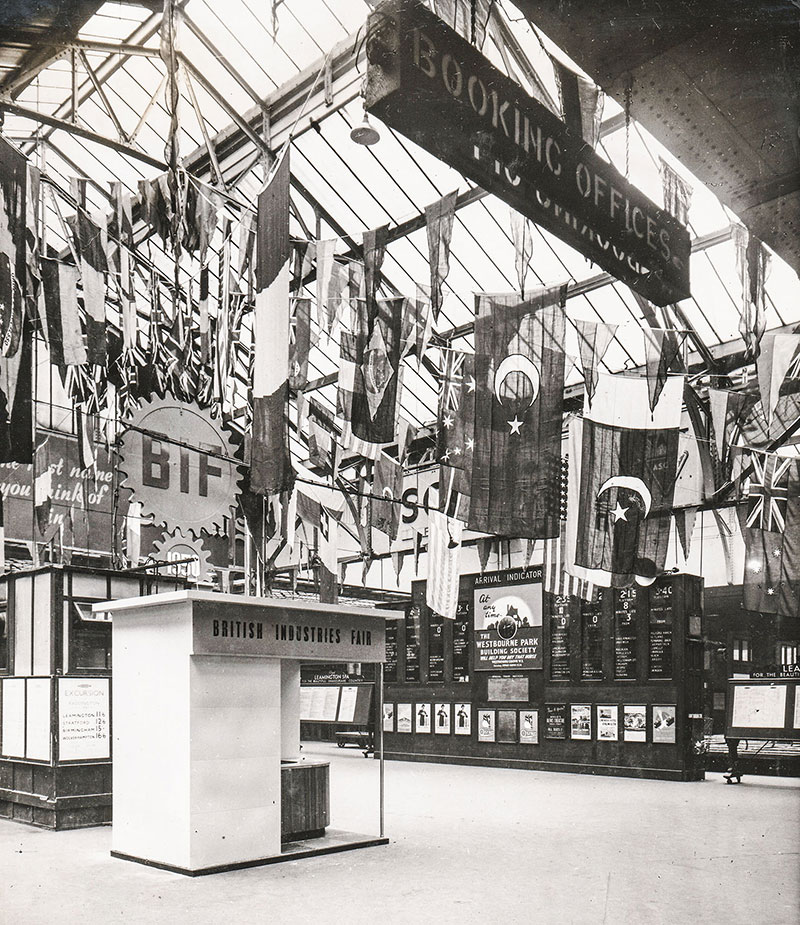
Station decorations at Paddington during the 1950 Fair, held from 8 – 19 May that year
“Another section representing the heavy industries was inaugurated at Castle Bromwich in Birmingham in 1920 with the aid of a grant for publicity from the Board of Trade. These two sections accompanied the London section which was held at Crystal Palace from 1920. In 1921, a Board of Trade Committee of Inquiry under the chairmanship of Sir Frank Warner recommended that the Glasgow section be discontinued and the Fair be maintained on an annual basis with one section in London and another in Birmingham. The Fair was held each year until 1957 except in 1925, the second year of the British Empire Exhibition at Wembley, and 1941 to 1946.
“The London section was held at White City from 1921, and in 1930 a second section was added and this was held at Olympia. From 1938 the two London sections were held at Olympia and the newly opened Earls Court building. The Birmingham section remained at Castle Bromwich.
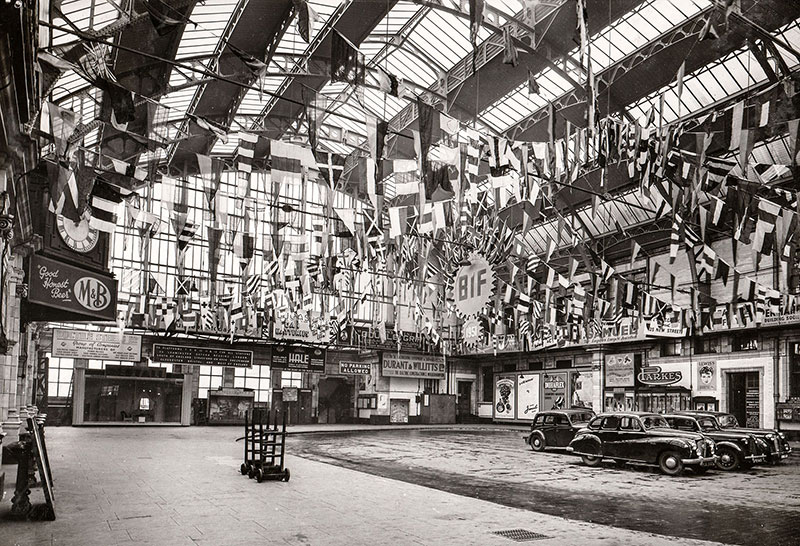
Station decorations at Birmingham Snow Hill during the 1951 Fair held from 30 April – 11 May that year
“By 1948 the purpose of the BIF was described by M Logan in The Histories of the Fair as being: ‘to show the world the strength of British industry, the craftmanship, the design and the quality that is implied in the words “British Made”.’
“Originally the responsibility for organising the London section of the Fair lay with the Board of Trade but it was transferred to the Department of Overseas Trade on 1 April 1919 who, together with the Birmingham Chamber of Commerce, were also responsible for the Birmingham Fair. It returned to the Export Promotion Department of the board in 1946, and was exercised by the new Commercial Relations and Exports Department of the board after 1 January 1949. After the 1954 Fair responsibility for organisation and management was transferred to a private company, British Industries Fair Ltd. The Company was voluntarily wound up on 20 February 1958 and the Fair has not been held since 1957.”
TUESDAY 6 FEBRUARY
Flights of Fancy
Two rather unusual posters from the Great Western Trust collection call for our attention this week. Neither of them features a railway scene even though they would have been posted at major railway stations. They are also both relatively modern although fifty years ago is ancient history in the world of advertising.
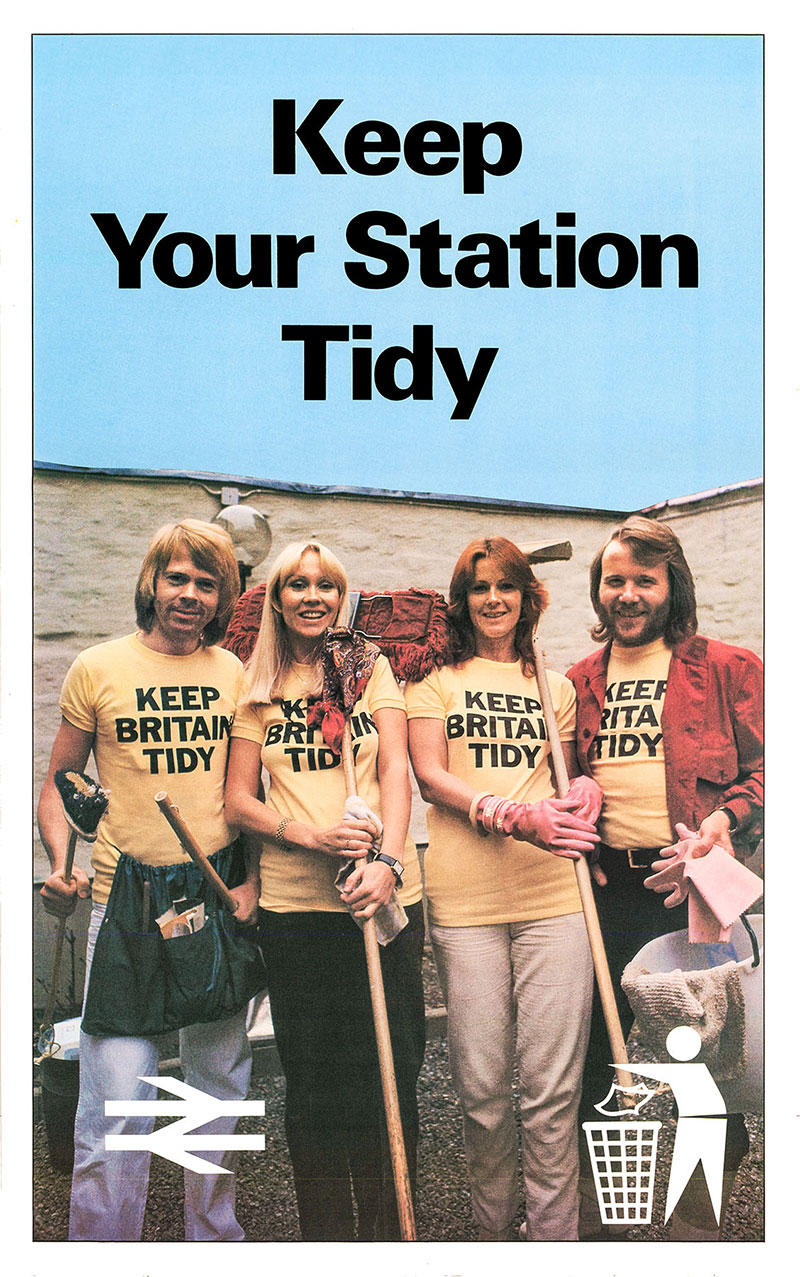
First we have Sweden’s most famous export – ABBA. Quite how their agent at the time persuaded them to pose with mops and buckets is a mystery but the old saying ‘no publicity is bad publicity’ certainly works in this instance. The band was formed in 1972 and found global fame two years later after winning the Eurovision Song Contest and the poster shown here was part of the image building process that followed. Despite not having worked together for more than forty years, they are as well known now as they were when on ‘cleaning duties’. Doubtless the poster would have been used at Waterloo, among many other stations.
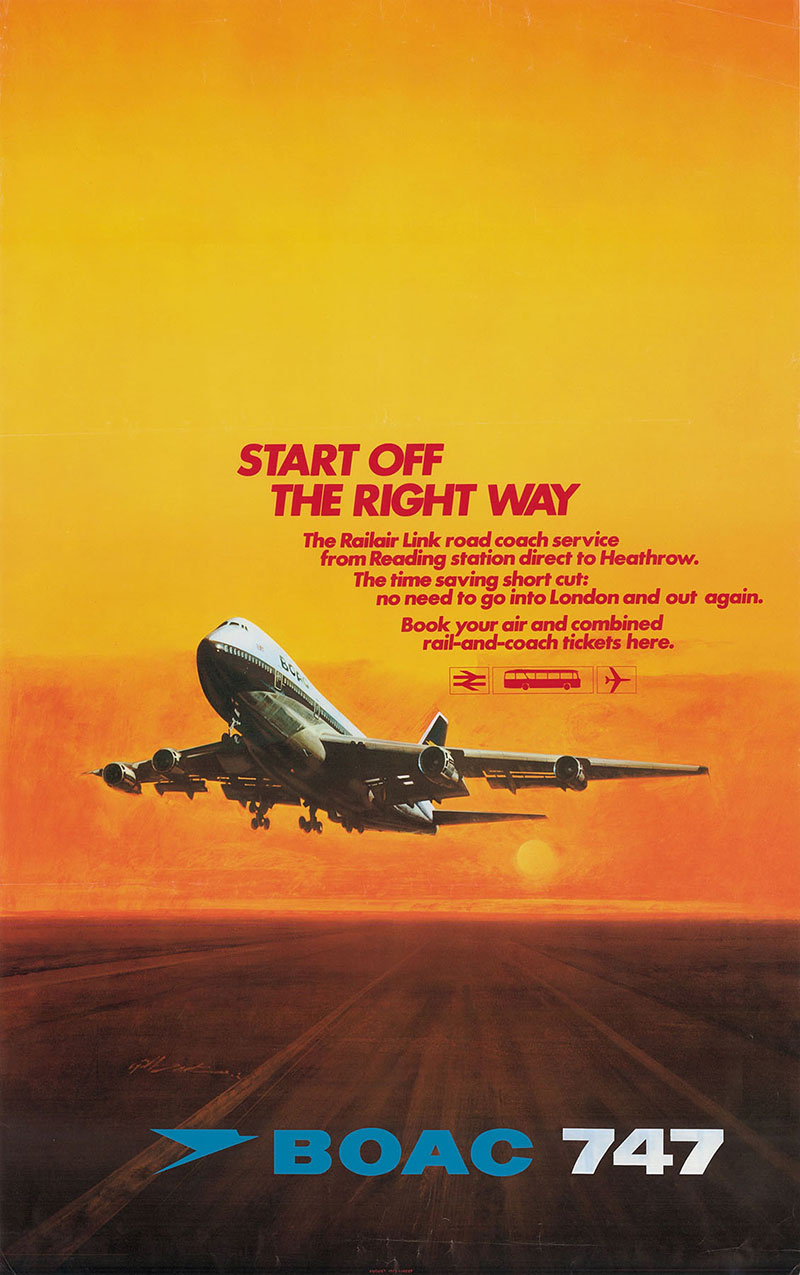
Next, from 1973, a poster promoting the Railair coach service from Reading Station to London Heathrow Airport which began on 6 March 1967. It is a powerful image showing a Boeing 747 just after take-off and uses a vivid low sun to light the sky above the aircraft. What makes the poster more remarkable is that 747s only flew in British Overseas Airways Corporation livery from April 1971 until March 1974 when British Airways was formed through the merger of the latter and British European Airways. BA flew these leviathans until the summer of 2020 when the COVID pandemic and the virtual collapse in international air traffic forced their early withdrawal.
 |
 |
 |
 |
Didcot Railway Centre Newsletter
Stay up to date with events and what's going on at Didcot Railway Centre.
You may unsubscribe at any time. We do not share your data with 3rd parties.